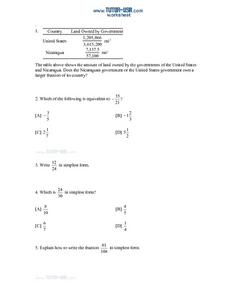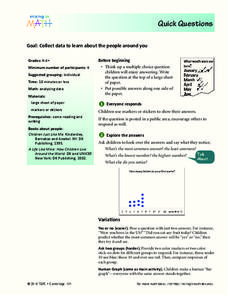University of Hawaiʻi
Taxonomy and Me!
Taxonomy is the study of organisms and how you phylum. Three biology activities are included, helping scholars understand four of the six kingdoms, specifically Protista, Plantae, Fungi, and Animalia. Scholars observe and classify in...
Curated OER
Application Problems with Fractions
In this math worksheet, learners compare fractions from a chart. They simplify six fractions. Students tell the fraction of a day they spend doing various activities. Each fraction is simplified. Three problems are multiple choice problems.
Curated OER
Math in English Skills IX Exercise Book
Wouldn't it be great if you had a packet of worksheets that covered percents, adding, dividing, and comparing fractions and decimals? Click here and print a workbook with over 20 well-scaffolded pages that will help your class practice...
Curated OER
Collecting Data to Learn About the People Around You
Human graphs, anyone? Did you eat fruit today? What is your favorite costume? Have your K – 6 learners graph the responses. Early elementary grades may count and compare while upper grades compare responses of different groups or make...
Curated OER
Fraction High-Low Card Game
In this fraction high-low card game, 5th graders make 45 fraction index cards. They play a game in groups of three where they add the fractions on two cards and guess high or low for the next person's sum. Then they answer 3 questions...
Curated OER
The Five Number Game
Students explain what it means to square numbers. They explain what it means to cube numbers. Students define prime numbers using their own language. They are introduced to the problem by playing one game as a class.
Curated OER
Quick Questions
Students ask their classmates survey questions. In this survey lesson, students come up with a question and possible answers. Their classmates mark their answers and the class discusses what they notice.








